How We Works Rain water Harvesting Chennai
General Information

Rainwater harvesting is a technique used for collecting, storing and using rainwater for landscape irrigation and other uses. The rainwater is collected from various hard surfaces such as rooftops and/or other man made above ground hard surfaces.
This ancient practice is growing in popularity due to interest in reducing the consumption of potable water and the inherent qualities of rainwater.
This website will focus on general information about rainwater harvesting systems, rainwater system advantages and disadvantages, and helpful links and references.
Rainwater Harvesting Basic Components
Rainwater systems come in all shapes and sizes, from simple catchment system under a downspout to large above and/or underground cisterns with complex filtration systems that can store thousands of gallons of water.
Most rainwater collection systems are comprised of the same basic components
- Catchment surface - rooftop or other raised solid surface. The best catchment systems have hard, smooth surfaces such as metal roofs or concrete areas. The amount of water harvested depends on the quantity of rainfall, the size of the surface and the slope of the catchment area.
- Gutters and downspouts - also known as distribution systems. They channel water from the catchment .area to a holding container such as a barrel, cistern or planted area
- Leaf screens - a screen that removes or catches debris.
- Roof washers - a device that diverts the "first flush" of rain before it enters the storage tank. Most rainwater suppliers recommend that the "first flush" of water is diverted to an outside area of the storage system since the catchment surface may accumulate bird droppings, debris and other pollution.
- Storage tanks - In general, the storage tank is the most expensive component of a rainwater harvesting system. There are numerous types and styles of storage tanks available. Storage can be aboveground or underground. Storage containers can be made from galvanized steel, wood, concrete, clay, plastic, fiberglass, polyethylene, masonry and more. Examples of aboveground storage include cisterns, barrels, tanks, garbage cans, aboveground swimming pools and more. Storage tank prices vary based on variables such as size, material and complexity. To inhibit the growth of algae, storage tanks should be opaque and preferably placed away from direct sunlight. The tanks should also be placed close to the area of use and supply line to reduce the distance over which the water is delivered. Also consider placing the storage on an elevated area to take advantage of gravity flow. The tank should always be placed on a stable and level area to prevent it from leaning and possibly collapsing.
- Delivery systems - gravity-fed or pumped to the landscape or other end-use areas.
- Purification/treatment system - needed for potable systems to make the water safe for human consumption. Please check with your local health department for information on filtration systems and certification requirements. Information is available at the County of San Diego Department of Environmental Health
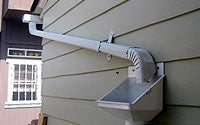
Rain gutters and downspout with debris filter
| 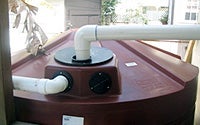
Storage tank shown with an inlet pipe and overflow tube
| 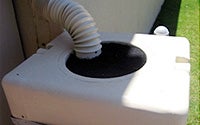
Inlet pipe with debris filter
|
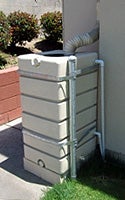
Rain barrel at San Ysidro Library
| 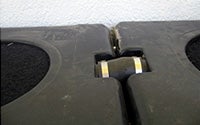
Serial connected rain barrels
| 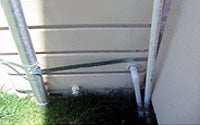
Rain barrel overflow tube
|
Rainwater Harvesting Advantages and Disadvantages
- Makes use of a natural resource and reduces flooding, stormwater runoff, erosion and contamination of surface water with pesticides, sediment, metals and fertilizers.
- Excellent source of water for landscape irrigation, with no chemicals such as fluoride and chlorine, and no dissolved salts and minerals from the soil.
- Home systems can be relatively simple to install and operate May reduce your water bill.
- Promotes both water and energy conservation
- No filtration system required for landscape irrigation
- Limited and uncertain local rainfall
- The payback period varies depending on the size of storage and complexity of the system
- Can take considerable amount of time to "pay for itself"
- Requires some technical skills to install and provide regular maintenance
- If not installed correctly, may attract mosquitoes (i.e.; West Nile Disease and other waterborne illnesses)
- Certain roof types may seep chemicals, pesticides, and other pollutants into the water that can harm the plants
- Rainwater collected during the first rain season is generally not needed by plants until the dry season. Once catchment is full, cannot take advantage of future rains
Safety Considerations
Parents/adults
Please make sure that children and pets do not climb on the storage systems and accidentally fall into the storage tank.
Storage tanks should have locking lids and/or bars that keep the children and pets out!
Standards and Regulations
Rainwater harvesting policies vary from state to state but there are no known local laws restricting rainwater harvesting at this time. In 2007, two bills were passed in the California State Legislature that require local water districts to create water conservation programs and building standards. However, neither bill discusses rainwater harvesting as a water conservation option. The American Rainwater Catchment Systems Association (ARCSA) has developed a standards guide that is being proposed to the International Association of Plumbing and Mechanical Officials (IAPMO) for inclusion in the Sustainable Plumbing Standard.
The City of San Diego's Stormwater Pollution Prevention Program is currently conducting a pilot study on rainwater harvesting at seven locations throughout the city's watersheds.
Source: sandiego.gov
Landtechindia is a multi-disciplinary firm of Architects in Chennai, India, with experience in Architecture
ReplyDeleteLandtechindia - Architecture Firms in Chennai,
rainwater harvesting chennai
ReplyDeleterain water harvesting in chennai
Thanks for sharing about rainwater harvesting have a look at
ReplyDeleteLorry Water Suppliers in Chennai
Private Lorry Water Suppliers in Chennai
Tanker Lorry Water Suppliers in Chennai